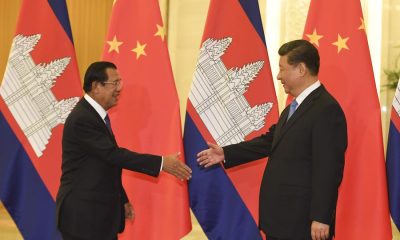Cambodia Has Become China’s Unofficial Representative in ASEAN

China has made a decisive move to strengthen ties with one of its main partners in Southeast Asia by opening its markets for duty-free trade. Leaders in Beijing and the Cambodian capital of Phnom Penh strengthened their political and economic ties at a time when the U.S. actively opposes China and the EU renewed sanctions against the Southeast Asian country.
The signing of a Free Trade Agreement was one of the main highlights of the Chinese Foreign Minister’s recent visit to Cambodia. This agreement will allow Cambodia to export up to 340 items to Chinese markets without being subject to tax. This could make up for the losses Cambodia has suffered because of declining trade with the EU. At the same time however, trade with China is developing positively, especially with agricultural products reaching Chinese markets.
In August 2020, the EU temporarily abolished the preferential trade regime that Cambodia enjoyed under the program “Everything but arms.” The sanctions are due to the EU’s so-called concerns about human rights in Cambodia and has mostly affected traditional exports – clothing, shoes, and tourism goods. In addition, in 2019, the EU sharply reduced imports of rice from Cambodia. The tariff restrictions were introduced in January for a period of three years. However, the loss was offset by an increase in sales of rice to China. In 2019, bilateral trade between China and Cambodia reached $8 billion. During Chinese Foreign Minister Wang Yi’s’s visit to Cambodia, the two sides agreed to raise this to $10 billion over the next three years.
The two countries regularly exchange high-level visits. In early 2018, Premier of the People’s Republic of China Li Keqiang officially visited Cambodia and updated the cooperation program between China and Mekong River basin countries. In early 2019, Cambodian Prime Minister Hun Sen paid a visit to Beijing. High-level negotiations took place on the eve of the Cambodian election, in which he won unconditionally, despite the opposition having support from the U.S. and the EU.
This time, Yi’s meeting with Cambodia’s top leader was held amid increasing pressure from the U.S. against Phnom Penh. Due to so-called concerns for Cambodia’s ecosystem and alleged widespread corruption, sanctions have been imposed against Chinese company Union Development Group. This company is involved in the construction of one of Southeast Asia’s largest tourist hubs, Dara Sakor, which will be located on Cambodia’s shores on the Gulf of Thailand. The project promises many billions of dollars in revenue for the Cambodian economy.
Recently, the U.S. has also expressed strong outrage over Cambodia’s demolition of an American-built military facility at the country’s largest naval base in Ream. The outburst from the U.S. has also been provoked by reports that China could be participating in the modernization of the base. During a meeting with Cambodian Foreign Minister, Prak Sokhonn, Yi assured that China would continue to strongly support Cambodia in defending its sovereignty and national dignity. For his part, Sokhonn affirmed that Cambodia wants to further develop relations with China.
This will further strengthen China’s position in the region as Cambodia openly acknowledges that it will by all means protect China’s interests in the region and promote economic projects between the two. Cambodia will persistently promote economic and political cooperation with China in the Association of Southeast Asian Nations (ASEAN). It is clear that Hun Sen is looking to manoeuvre in some way by openly declaring the diversification of its economic strategy with China as a visible and vocal friend.
Cambodian Deputy Prime Minister Hor Namhong recently called on powers outside of the region to not interfere in issues in the South China Sea and supported China’s statement saying that Beijing is ready to resolve this issue peacefully on the basis of respect, historical accuracy and in accordance with international law.
Although Cambodia is not a stakeholder in the territorial dispute in the South China Sea, it has repeatedly announced which side of the dispute it is on. For example, in 2012, as Chairman of ASEAN, Phnom Penh firmly opposed the inclusion of a summary statement condemning Beijing’s actions in its dispute with the Philippines in the South China Sea, and therefore, for the first time in ASEAN history, the summit’s key document was not passed. Then in 2016, Cambodia once again supported China by rejecting the proposal to include any mention of the decision by the Permanent Court of Arbitration in The Hague that ruled against Beijing’s claims of sovereignty over most of the South China Sea. Because of the lack of a necessary consensus among all ASEAN members, the passage referring to the final Hague ruling was not recorded in the summary document.
Cambodian-Chinese relations are mutually beneficial. As the EU sanctions the Southeast Asian country as it allegedly violated the “Everything but arms” program, China has strongly stepped in to make up Cambodia’s lost revenue. In return, Cambodia has become a strong and unapologetic backer of China, even turning against fellow ASEAN members in their dispute with Beijing over the South China Sea. Cambodia, as a country with no stake in the South China Sea dispute, will continue being a country representing Beijing’s interest in ASEAN while it also becomes a pivot for China to more easily expand its influence across Southeast Asia, particularly in Laos.
*
Note to readers: please click the share buttons above or below. Forward this article to your email lists. Crosspost on your blog site, internet forums. etc.
This article was originally published on InfoBrics.
Paul Antonopoulos is an independent geopolitical analyst.
Featured image is from InfoBrics

